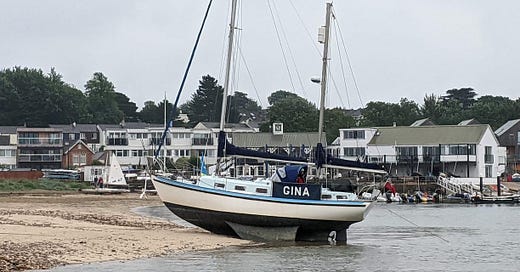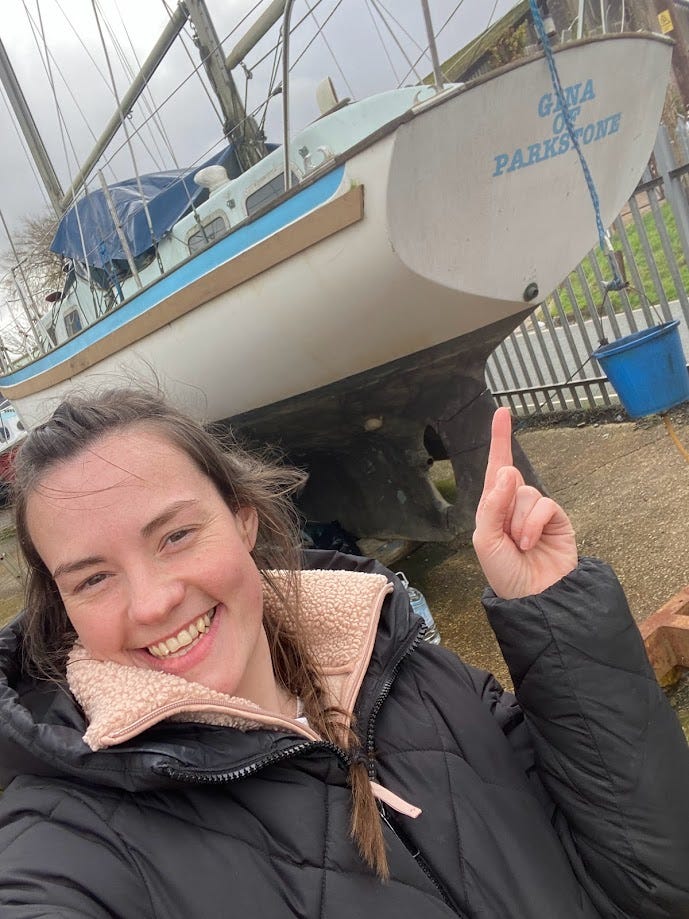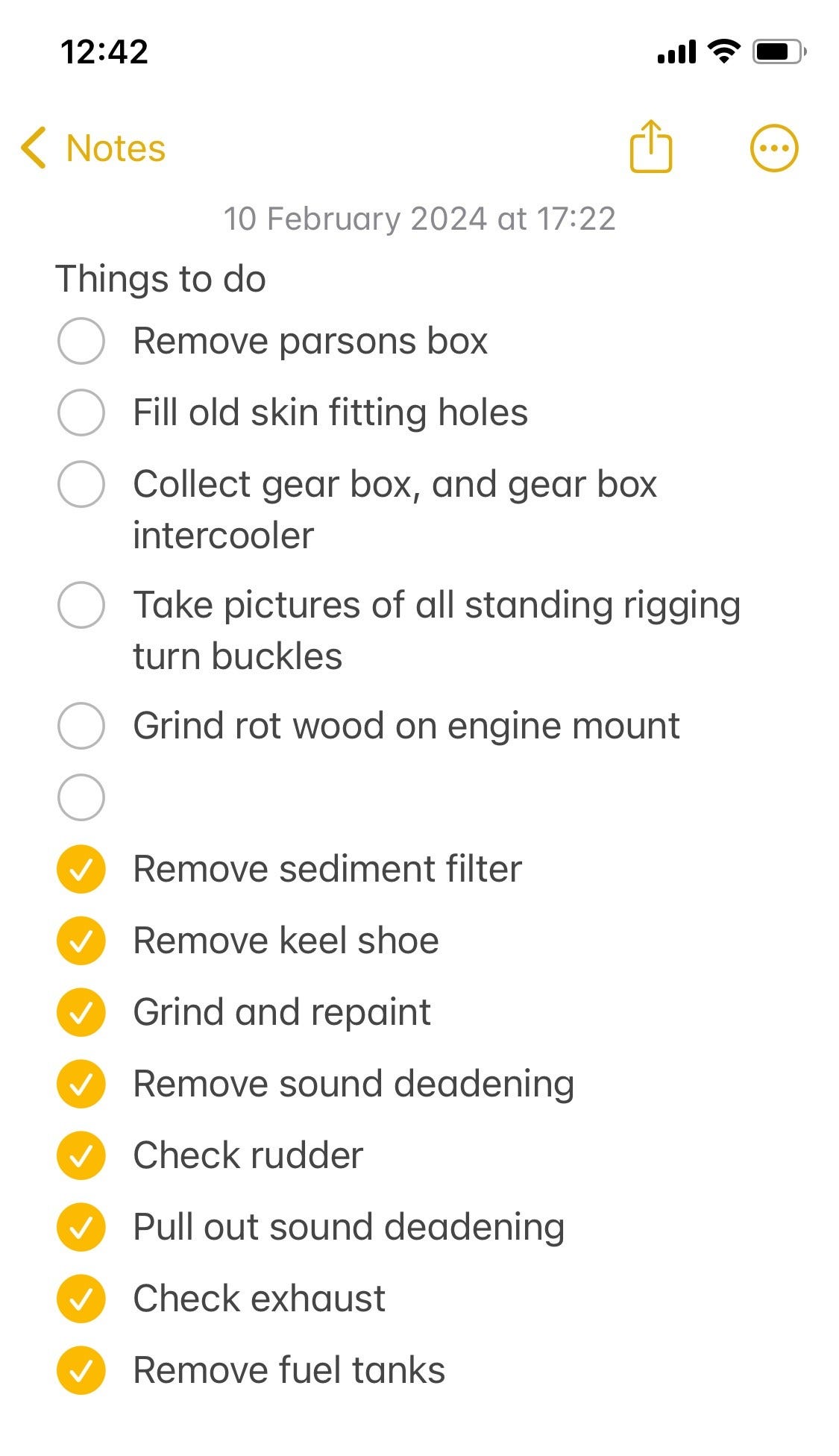Sailing Gina #4 - Rust, Rust & More Rust
Ever plan like you have all the time in the world, but then it takes 5 hours just to empty some fuel tanks and nearly your whole weekend has gone? Yeah, that's us.
Hello, I’m Helen - follow along as I write about two novice sailors refitting their 1970s sailboat, Gina. We have ZERO sailing experience but have given everything up for a life on the water. Read our adventures as we prepare her and ourselves for the big launch.
We left Gina in October 2023 for most of the winter and were joyously reunited in early February 2024.
As mentioned in previous newsletters, Ryan spent the winter rebuilding the engine and focused on planning for future projects on Gina. I finished training for a marathon but ended up suffering from a herniated disc and could not complete it. We enjoyed Christmas and celebrated with the engine in the kitchen and then January was my birthday. We told friends and family our plans to move aboard Gina, started to pack the house up and I put my notice in at work. All with the deadline of April 12th for the boat relaunch!
The drive down to the Isle of Wight consisted of us making a list of what we would like to achieve on this visit:
As usual, we overestimated what we could achieve over a winter weekend; 9 hours of daylight, and freezing temperatures added to our difficulties. We arrived by early afternoon Friday with just 3 hours of sunlight left.
The first task on the list was to empty the fuel tanks, once they were empty we could remove them. Well, this process took hours; Dave who owned Gina before us had just filled both tanks to almost full we even found the receipt, and we were trying to empty them via their tiny spouts. Now, we could have set up a syphon to empty them slightly faster but we didn’t have any hose or piping long enough onboard, so emptying via the tap it was… surely there wasn’t that much in them…
Well, 20L jerry can, after 20L jerry can, we can confirm there was a lot of fuel in them, midday Saturday they were finally empty.
Ryan scooted the fuel tanks into a more accessible position, we fed a bolt attached to a rope through the wider opening at the top of the tank, this then provided the traction/leverage needed to hoist them out of the bilge and onto the deck, and from there onto the ground. Again we used the boom, a pretty heavy-duty carabiner and some line.
After we lowered the first fuel tank to the ground, we tried to remove the bolt from inside the narrow opening and realised the bolt was stuck inside lengthways, against the opening, we couldn’t get the end of the bolt to pull it out. After 30 minutes of messing about and much swearing later, we eventually got it out with a small, claw, pick-up tool! We repeated this effort on the second tank, bolt inside, attached to a line, through the carabiner on the boom. We had learnt our lesson and this time tied a small length of string to one end of the bolt, we could pull on the string to get the bolt out - it worked the first time, in seconds.
As you can see they were in a pretty sorry state, flakes of paint and metal chipping off and covered in rust. Ryan had planned to clean and recondition these tanks himself grinding and sanding off the old layers and bringing them back to bare metal. Then priming and painting them, as good as new. Having pulled them out and realising the extent of the rust and corrosion we opted to have them professionally sandblasted, treated and painted. We contacted a local company to the boat yard and he would collect them and drop them off.
All of that rust and chipped-off paint must have been going somewhere, so back into the bilge I went. More scraping of grit and rust away which had been left behind from the tanks, then cleaning where the tanks had been and pulling out more rockwool sound deadening.
Cleaning under where the fuel tanks had been, highlighted more work and what would be a potentially big issue for us!
Rusty keel bolts!
A keel is a structural element running along the bottom of a boat or ship's hull, providing stability, strength, and hydrodynamic efficiency. It lowers the vessel's centre of gravity to prevent capsizing and supports the hull's structural integrity. Gina has bilge keels, a variant featuring two keels mounted on either side of the hull, which are particularly useful in cruising in shallow waters. They allow the boat to remain upright when grounded and reduce rolling motions, providing added stability.
So, the keel bolts: we couldn’t tell if it was just surface rust or if the corrosion was throughout them, what strength and stability did they have left in them? Were they going to snap or break, causing one of our bilge keels to come off mid-sail? We had a million worries and concerns and an investigation was needed on how to replace them.
There wasn’t much time left on the Island before we had to head back to Manchester so we focused on other tasks. I continued to clean the bilge through to Sunday when we set off for home and Ryan began looking at different areas of the boat.
Ryan wanted to remove our rudder shoe as it was likely that the bearing inside was worn or perhaps slightly misaligned as there was a lot of play in the rudder.
The rudder is a movable surface used to steer vessels by redirecting the flow of water. By turning the rudder it creates pressure differences that generate a force to change direction. On boats, it is typically mounted at the stern beneath the hull. The rudder shoe is a structural part that supports the rudder and helps to guide and stabilise it. The rudder shoe is typically mounted at the base of the rudder and is designed to bear the loads and stresses that occur during steering. It helps ensure smooth operation and longevity of the rudder by reducing wear and tear on the rudder and the surrounding components.
Ryan worked on removing the bronze bearings holding the rudder shoe in place, a lot of banging later it was free! We brought the rudder shoe home and planned to have a new bearing machined.
Alongside removing the rudder shoe, Ryan also removed our cockpit console. This was so he could understand the wiring behind the console to the engine and other electrical components better. We also brought the gearbox home so Ryan could strip it of the old paint, prime and repaint it and attach it back to the engine block.
Driving home that weekend, we’d tackled some but not all of our to-do list and somehow had added bigger, longer and more complex jobs to it.
In addition, it seemed we were still bringing more things home from Gina but returning nothing. The April deadline was looming and it was difficult to understand how we would tackle everything.
Song of the week
This week’s recommendation is from a wonderful artist called Nick Mulvey from his first album named after the title track First Mind. He has been a favourite artist of mine for quite a few years and Ryan and I had the pleasure of seeing him live in 2017 back in the same venue to celebrate our 5th anniversary.
Nick Mulvey - Fever to the Form
Cause the very thing you’re afraid of
It keeps you clean but unclear
It’s the dirt that you’re made of
And that’s nothing to fear
No, it’s nothing my dear
This section of the song emphasises the importance of embracing one's flaws and fears as integral parts of the human experience. It encourages us to accept and understand our fears rather than avoid them, recognising that they contribute to our personal growth and self-clarity. Avoiding fear keeps you safe but prevents you from fully understanding yourself and the world around you.
All we want, we have within us, and we need not fear. Have faith and confidence in yourself and you can achieve whatever you set your heart, soul and mind to.
Follow along for our next newsletter where we have a week-long stay on the Isle of Wight. We get many BIG jobs buttoned up, and things start becoming neat and organised (the bilge and engine bay anyway, the rest of Gina not so much).
I’d love to feature your questions in future newsletters! You can send them via email to helen.hume@hotmail.co.uk, through Instagram DMs, or by adding a comment below. For real-time, daily updates, follow me on Instagram @helen.hume or click the icon below.
Fair winds & following seas,
Helen, Ryan & Gina
If you found this post useful or enjoyable, I would be incredibly grateful if you could share it or restack it. Doing so helps more people discover Sailing Gina and all the adventures we have in store. Thank you! x

















